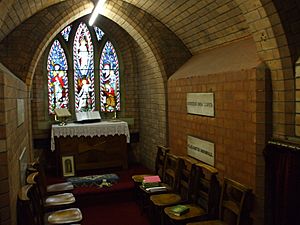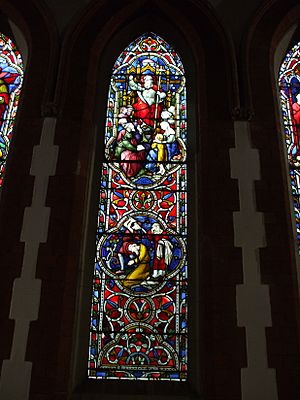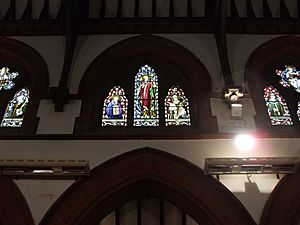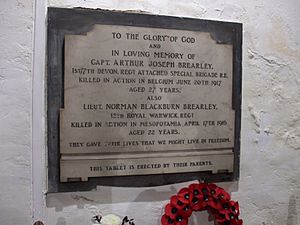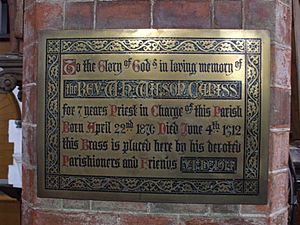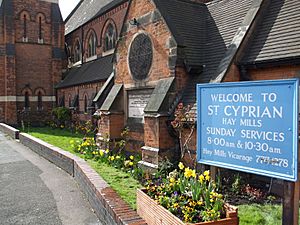St Cyprian's Church, Hay Mills facts for kids
Quick facts for kids St. Cyprian's Church, Hay Mills |
|
|---|---|

St Cyprian's Church, Hay Mills
|
|
| Denomination | Church of England |
| Churchmanship | Broad Church |
| Website | http://www.achurchnearyou.com/hay-mill-st-cyprian/ |
| History | |
| Dedication | St. Cyprian |
| Administration | |
| Parish | Hay Mills |
| Deanery | Yardley and Bordesley |
| Archdeaconry | Aston |
| Diocese | Birmingham |
| Province | Canterbury |
St Cyprian's Church, Hay Mills is a beautiful church in Hay Mills, Birmingham, England. It belongs to the Church of England. You can find it on the south side of the main road from Birmingham to Coventry (the A45). The church is located at the end of a small lane called the Fordrough.
This church has a special connection to the Horsfall family. They built it and still own it today. It was built in the 1800s using red bricks, in a style called Gothic Revival. The church is named after St Cyprian, who was an important Christian leader in the 200s AD. He was known for giving his money to the poor and was executed by the Romans in 258 AD. Today, St Cyprian's Church is a Grade II listed building, which means it's an important historical place.
Contents
A Look at History
How the Church Began
The story of St Cyprian's Church starts with James Horsfall. He was a clever inventor who made very strong steel wire. He moved his business to Hay Mill, an old factory by the River Cole. In 1855, his company joined with another, and they became famous for making special wire. This wire was used for things like piano strings, needles, and even the first successful transatlantic telegraph cable in 1866!
James Horsfall cared about his workers. He built houses for them and, in 1860, he built a schoolroom for their children. This schoolroom later became a small church, or Chapel. A new schoolroom was built next to it in 1863.
Building the Church
Church services started in the chapel, and a Sunday School began for children in 1866. Over time, more parts were added to the building. In 1873, work started to turn the old chapel into the main part of the church, called the chancel.
New sections were added, including the main hall (the nave), side areas (aisles), a gallery, a porch, a tower, and a tall, pointed roof (a spire). The church was finished and officially opened in 1878. During the Second World War in 1940, the church was damaged by bombs, but it was repaired.
Church Design
Gothic Style and Features
St Cyprian's Church is built in the Gothic style. It's mostly made of red bricks, with some black bricks and stone details. The roof is made of tiles.
Inside, the church has a large main hall called the Nave with a special "hammer beam" roof. There are tall windows high up (clerestory windows) and narrow aisles on the sides. The chancel, at the west end, has a rounded roof. There are also rooms for the clergy (vestries) with a gallery above.
In one corner, there's a tower with a pointed roof (a broach spire). This tower holds a bell from 1749! In another corner, you'll find the Horsfall mortuary chapel. This chapel was added in 1877 to remember James Horsfall's daughter, Elizabeth. It's now where James Horsfall and his family are buried. It's like a special family burial place within the church. Above the entrance to this chapel, there's a sculpture showing the Transfiguration or perhaps the Ascension of Jesus.
Beautiful Stained Glass
Windows by Hardman & Co.
The church has many amazing stained glass windows, made by a famous company called Hardman & Co.. They also made the stained glass for the Houses of Parliament!
Some windows in the North aisle are lit up so you can see them clearly, even though they don't get natural light. This lighting was added thanks to a donation from a church member. In 2010, these windows were blessed with a special prayer, remembering John Ellison, in whose memory the lights were installed.
West Front Windows
If you go up to the gallery, you can see the stained glass windows at the West front up close. The round window at the top shows a dove, which is a symbol of the Holy Spirit.
Below it are three tall, narrow windows:
- The left window shows the birth of Christ and the Annunciation to Mary.
- The middle window shows St Cyprian preaching and then his martyrdom (when he was executed).
- The right window shows Jesus being presented at the temple and the adoration of the magi.
South Aisle Windows
As you walk towards the Horsfall Chapel, you'll see five more tall windows. These windows show five of the apostles: St Bartholomew, St Philip, St James, son of Alphaeus, St Paul, and St Peter.
North Aisle Windows
In the North aisle, the windows show the other seven apostles and the Virgin Mary: St Simon, St Jude, St Thomas, St Matthew, St Andrew, St James, son of Zebedee, St John, and Virgin Mary. These windows were lit up in 2009, so they look wonderful.
Clerestory Windows
The windows high up in the North side of the church show female saints, while those on the South side show male saints.
South Clerestory Windows
Looking from the back to the front of the church:
- First window: St Alban (the first British Christian martyr), St George (slaying the dragon), and St Edmund (holding an arrow, showing how he died for his faith).
- Second window: St Cuthbert, St Benedict (holding a book about his rules for monks), and St Germanus.
- Third window: St Ethelbert (a King who became Christian), St Augustine (who brought Christianity to England), and St Bennet Biscop.
- Fourth window: St Cyprian (holding an axe, a symbol of his martyrdom), St Edward the Confessor, and St Chad (holding a model of the Cathedral he founded).
- Fifth window: Venerable Bede (holding a book about English history), St Oswald (an English royal saint), and St Dunstan (a Bishop).
- Sixth window: St Stephen (holding stones, showing how he died), St Gregory (a Pope who sent missionaries to Britain), and St Laurence (with a grid iron, a symbol of his martyrdom).
North Clerestory Windows
- First window: St Bertha (a Queen who helped bring Christianity to England), St Helen (mother of Emperor Constantine), and St Margaret of Scotland (known for helping the poor).
- Second window: St Frideswide (Patron Saint of Oxford University), St Walburgh, and St Winefride (holding a head, a symbol of her martyrdom).
- Third window: St Edith (a princess who chose to be a nun), St Hilda (an Abbess, though the glass wrongly names her St Chad), and St Etheldreda (another Abbess).
- Fourth window: St Barbara (patron saint of dangerous jobs), St Lucy (with a lamp and eyes, patron saint of the blind), and St Faith (with a grid iron, symbolising her death by burning).
- Fifth window: St Cecilia (Patron Saint of Music, with an organ), St Catherine, and St Agnes (with a lily, symbol of purity).
- Sixth window: St Dorcas (raised from the dead by St Peter), St Lydia (the first Christian convert in Europe), and St Lois (Timothy's grandmother, praised for her faith).
- Seventh window: Santa Maria Mag (Mary Magdalene with an oil pot), St Anne (Mary's mother, though wrongly named St Hilda), and Santa St. Elizabeth (Mary's cousin and mother of John the Baptist).
Font and Pulpit
The Angel Font
The church has a beautiful font made of white marble. It features an angel holding a large shell. This angel's face is believed to be modeled after Mary Elizabeth Simms, James Horsfall's daughter, to whom the font is dedicated.
The words on the font say: "Erected to the memory of Mary Elizabeth Simms the only and dearly beloved daughter of James and Elizabeth Horsfall - Sept-1879. "In life beloved, in death lamented"
The Pulpit Figures
The pulpit, where the priest gives sermons, is supported by three figures. One is St Peter, shown with a key. Another is a Bishop, representing St Cyprian. The third is St Paul, shown with a book and a broken sword.
Special Memorials
War Memorials
In the South aisle, there's a simple wooden memorial with 111 names. It remembers the men from the church and parish who died in the First World War (1914-1918). There's also a memorial for six members of the Boys' Brigade who died in the Second World War.
Two other memorials are for members of the Horsfall family who died while serving in the military. One is for James Andrew Coldwell Horsfall, who died in 1973 while saving his comrades. The other is for Flying Officer George David Coldwell Horsfall, who went missing during operations in 1944.
Other Memorials
There are also two brass plates in the South aisle:
- One remembers William George Gray (died 1860) and his wife Hannah (died 1871).
- The other remembers James Evans (died 1870) and his two wives, Honara and Mary Ann.
In the North aisle, you'll find a special memorial for two brothers, Captain Joseph Arthur Brearley and Norman Blackburn Brearley. They both died in the First World War. Arthur was a schoolteacher who joined the army and was killed in 1917. His brother, Norman, was killed in action in 1916.
Their memorial says: They died that we might live in freedom. This tablet is erected by their parents
Also in the North aisle are three brass plate memorials for the Spawforth family:
- Edward Spawforth (died 1853)
- John Spawforth (died 1865)
- Mary Spawforth (died 1859), Edward's wife.
Church Leaders
List of Vicars
At the back of the church, there's a wooden board listing all the vicars (priests) who have served St Cyprian's since 1866. This board was put up in 1973 to celebrate the church's 100th anniversary.
Some of the vicars include:
- 1866–1903 G.H. Simms (who was married to Mary, James Horsfall's daughter)
- 1904–1910 W.H. Wilson Carriss (there's a brass plaque for him too)
- 2001–2005 An "Interregnum" (a time without a vicar, when a Lay Pastoral Team helped lead the church)
- 2010–2011 Another Interregnum with a Lay Pastoral Team
- 2012–2017 R. Anetts
- 2017– Present Interregnum with a Lay Pastoral Team
The Church Organ
The church has an electronic organ. It replaced an older organ in the 1960s. A plaque on the organ thanks church members and friends for helping to rebuild it, and Alan Pipe and Albert Dixon for restoring the wood.
List of Organists
Here are some of the people who have played the organ at St Cyprian's:
- Samuel Simms 1879–1885
- Derek Hulley 1970–2005 (a memorial plate remembers him and his wife Joyce)
- Margaret Croucher 2000-to present
What Happens Today
St Cyprian's Church is still open and has a lively group of people who attend services. They also help with missions in Africa and other places.
Every Sunday, there are Holy Communion services. Throughout the week, there are other activities like a ladies' group called "Grapevine," a Bible study group, and morning prayers. The church also organizes special events like Bingo afternoons and concerts.
St Cyprian's has a modern church hall nearby that can be rented out. It's even used by religious groups from different faiths. In front of the church, there's a small memorial garden that was renovated by volunteers in 2009.


